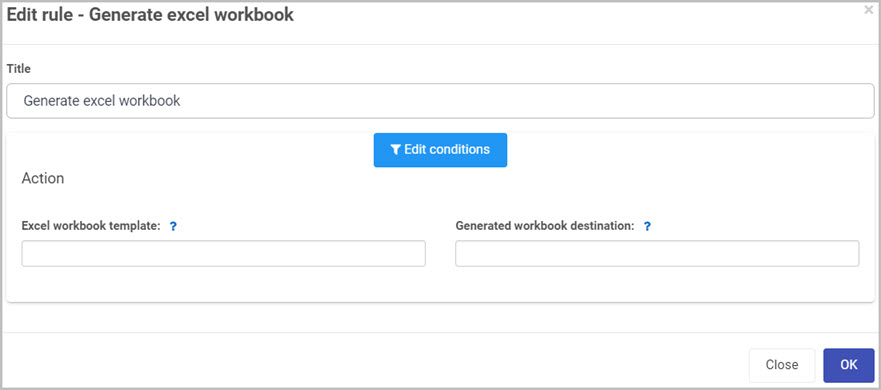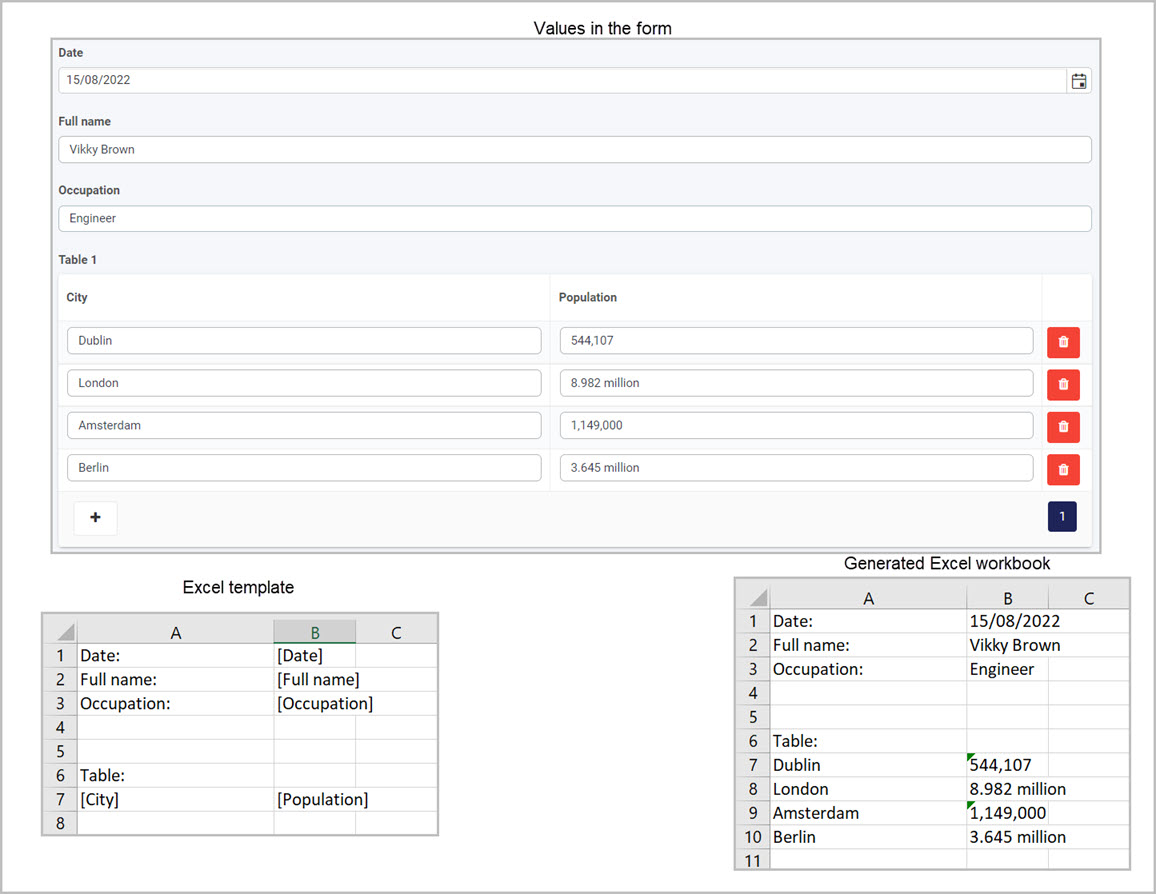Generate excel workbook
Introduction
This rule generates an Excel workbook from data stored in a process using an Excel .xlsx template. The Excel template needs to be pre-created before using this rule and must be attached to a file field, this way the rule will know which template you want to use when creating the workbook.
When to use
Use this rule when your process requires dynamic workbook generation where the structure of those workbooks is the same for every instance, but the values of fields are different. Use this rule with combination of the Table control to output big tables and transfer them into the Excel workbook, to learn more about table control go to Table control. This rule will use an Excel template previously mapped with smart tags. Smart tags are created in Excel when a field is selected using the Kianda add-in task pane, and then inserted into the document, see image below for more details.

You can add this rule:
- to a field
- to a form
- to a process (the rule will run on load)
Before you get started
In advance of using the Generate Excel workbook rule, in your process you need to have created at least one or more forms. The rule also requires two file fields, one for storing the Excel template and the other for storing the generated Excel workbook. To learn how to add a file go to File upload control.
- File field (Template) - used as a container to store the Excel template used to generate the workbook.
- File field (Generated Excel workbook) - used as a container to store the generated Excel workbook.
An Excel template that is used to generate the Excel workbook also needs to be pre-created using the Kianda add-in for Excel. You can make each generated Excel workbook very dynamic by using the smart tags that Kianda add-in uses to retrieve information for your form fields and places the values into the Excel workbook when generating it. To learn more about how to install and use Kianda add-in in Excel, go to Excel workbook add-in.
How to get started
-
Click on an existing process by going to Administration > Designer and decide which form, or field you will apply the rule to, by clicking on that item so that it is in edit mode so you can see the Edit/pen button, Pen button
 .
. -
Click on Add a rule > File management > Generate excel workbook.
-
In the Edit rule - Generate excel workbook dialog box, give the rule a title in the Title field.

-
If you want to add conditions for the rule, click on the Edit conditions button
 , see Conditions for more details.
, see Conditions for more details. -
Under the Action section fill out the following:
-
Excel workbook template - select a file field that stores the Excel template. Your template can pull all values from Input fields in the Controls section of Kianda. For example if a text box field contains “This is a test” text, the value pulled into the generated Excel workbook is “This is a test”.

-
Generated workbook destination - select a file field that will store the generated word document.
-
-
When you are finished editing the dialog box, click on OK or click on Close at any time to exit the dialog box.
Editing, deleting or duplicating rules
When you have clicked on an existing rule, and the rule is visible in the right-hand pane under Rules, there are a number of options available to you.
- To disable a rule, click the slider across beside the rule name.
- To copy a rule, click on the Duplicate button
 beside the rule name.
beside the rule name. - To delete a rule, click on the Bin/Trash button
 .
. - To view a rule, click on the rule name to open the Edit rule dialog box.
User tip 
- When using this rule, create a utility panel and make it invisible to other users. You can then move the Excel template file field and the generated Excel workbook file field inside the utility panel. This way other users will not be able to see the unnecessary file fields and will not be able to tamper with them. To see an example of a utility panel, go to Creating a utility panel.
- Use this rule when working with tables inside of Kianda. It is very easy to create an Excel spreadsheet by transferring data from your processes into Excel using the Excel add-in. Use smart tags from the add-in to add a table, the data from your table will be transferred into the Excel spreadsheet without manually typing them. See Excel workbook add-in for more detail.
What’s next 
To find out more about other File management rules go to File management rules.
To find out more about other rules go to Rules.
Feedback
Was this page helpful?
Glad to hear it! Please tell us how we can improve.
Sorry to hear that. Please tell us how we can improve.